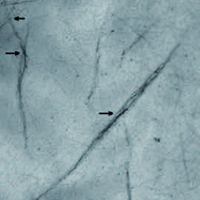 Smart Citations
Smart CitationsSee how this article has been cited at scite.ai
scite shows how a scientific paper has been cited by providing the context of the citation, a classification describing whether it supports, mentions, or contrasts the cited claim, and a label indicating in which section the citation was made.
Fibrinogenolytic activity of protease from the culture fluid of Pleurotus ostreatus
The use of proteases makes it possible to obtain partially hydrolyzed forms of macromolecules with unique properties. The importance of proteases for studying the structure and functions of fibrinogen forces scientists to search for new sources of highly specific proteases. Thus, the aim of this work was to study the content of the Pleurotus ostreatus culture fluid in search of fibrinogen- specific proteases. P. ostreatus was cultured for 14 days at 27°C. The culture fluid was collected and the protein fraction was salted out with NaCl and then dialyzed. Fibrinogen hydrolysis products by P. ostreatus protease were characterized using SDS PAGE under reducing conditions followed by immunoprobing using murine monoclonal antibodies I-5A (anti-Aα505-610) and 2d2a (anti-Bβ26-42). The study of turbidity and platelet aggregation was performed using a Multiskan FC spectrophotometric microplate reader and a SOLAR-2110 aggregometer, respectively. Electron microscopy of fibrils formed by truncated compared with native fibrins was performed using a transmission electron microscope N-600.
Analysis of the products of fibrinogen hydrolysis with a fungal protease using SDS-PAGE demonstrated the cleavage of the alpha chain of fibrinogen exclusively with the formation of a truncated form of fibrinogen in which there are no C-terminal portions of αC regions with a molecular weight of 25 kDa. A study of turbidity showed that the polymerization of truncated fibrin is significantly impaired. The rate of lateral association of protofibrils significantly decreased from 1.5 to 2.2 times in the case of truncated fibrinogen compared to the native one depending on the initial concentration of fibrinogen. It was shown that platelet aggregation in the presence of fibrinogen without 25 kDa fragments of αC regions was less effective than in the presence of native fibrinogen. Application of the preparation of the fungal protease allows us to obtain high molecular forms of the fibrinogen molecule with cleaved 25 kDa peptides, which provide new information on the role of these peptides in the fibrinogen functioning.
How to Cite
PAGEPress has chosen to apply the Creative Commons Attribution NonCommercial 4.0 International License (CC BY-NC 4.0) to all manuscripts to be published.

 https://doi.org/10.4081/jbr.2020.9006
https://doi.org/10.4081/jbr.2020.9006





